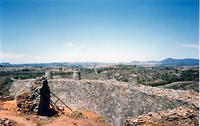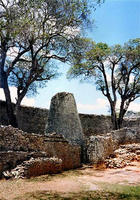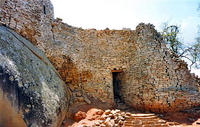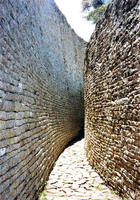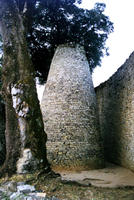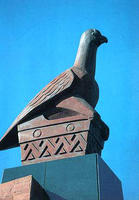You are in: Africa -> Zimbabwe -> Great Zimbabwe Natio... , and traditional search or Image Gallery will yield results of this site only
Great Zimbabwe National Monument
| Site number: | 364 |
|
| Type of site: | Cultural | |
| Date: | 11-15th century | |
| Date of Inscription: | 1986 | |
| Location: | Africa, Zimbabwe, Masvingo (Southern) Province | |
Up to 75 images are shown here. Click on each for more details or on Image Gallery for more images.
| Description: | The ruins of Great Zimbabwe, according to an age-old legend, were once the capital of the Queen of Sheba. They now stand as a matchless witness of the Bantu civilization of the Shona (11th-15th centuries). The almost 80 ha city was an influential trading centre and made a renowned name for itself as of the Middle Ages onwards. --WHMNet paraphrase from the description at WHC Site, where additional information is available. | |
| The Great Zimbabwe, or "stone buildings", is the name given to stone ruins spread out over a 722 ha area within the modern-day country of Zimbabwe, which itself is named after the ruins. It is near the modern town of Masvingo, which before majority rule was called Fort Victoria. The word "Great" distinguishes the site from the many hundred small ruins, known as Zimbabwes, spread across the Zimbabwe highveld. Construction starting in the 11th century and continuing for over 300 years, the ruins at Great Zimbabwe are some of the oldest and largest structures located in Southern Africa. At its peak, estimates are that the ruins of Great Zimbabwe had as many as 18,000 inhabitants. The ruins that survive are built entirely of stone. The ruins span 1,800 acres (7 km²) and cover a radius of 100 to 200 miles (160 to 320 km). In 1531, Vicente Pegado, Captain of the Portuguese Garrison of Sofala, described Zimbabwe thus: “ Among the gold mines of the inland plains between the Limpopo and Zambezi rivers there is a fortress built of stones of marvelous size, and there appears to be no mortar joining them.... This edifice is almost surrounded by hills, upon which are others resembling it in the fashioning of stone and the absence of mortar, and one of them is a tower more than 12 fathoms [22 m] high. The natives of the country call these edifices Symbaoe, which according to their language signifies court." The ruins can be broken down into three distinct architectural groups. They are known as the Hill Complex, the Valley Complex and the famous Great Enclosure. The Hill Complex was used for as a temple, the Valley complex was for the citizens, and the Great Enclosure was used by the king. Over 300 structures have been found so far in the Great Enclosure. The type of stone structures found on the site give an indication of the status of the citizenry. Structures that were more elaborate were probably built for the kings and situated further away from the center of the city. It is thought that this was done in order to escape sleeping sickness. Great Zimbabwe has been a UNESCO World Heritage Site since 1986. --Wikipedia. Text is available under the Creative Commons Attribution-ShareAlike License. | ||
| Source: | http://whc.unesco.org/en/list/364 | |
| Reference: | 1. UNESCO World Heritage Center, Site Page. | |







